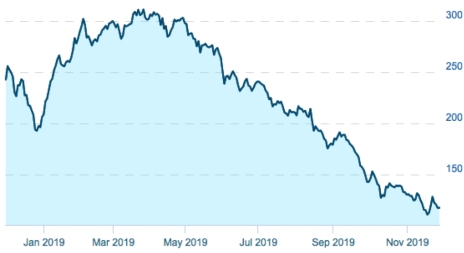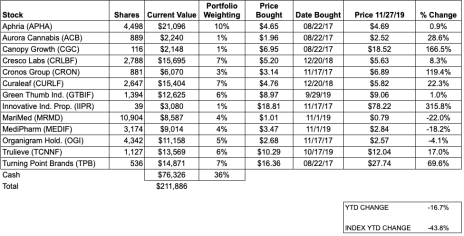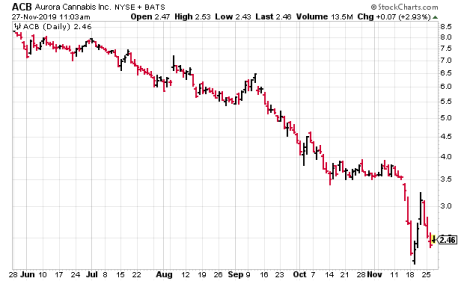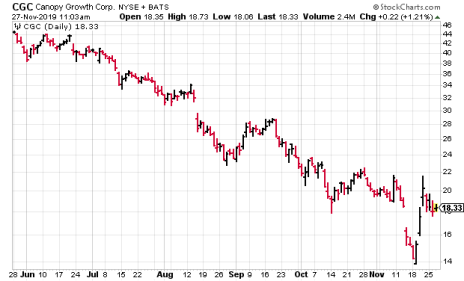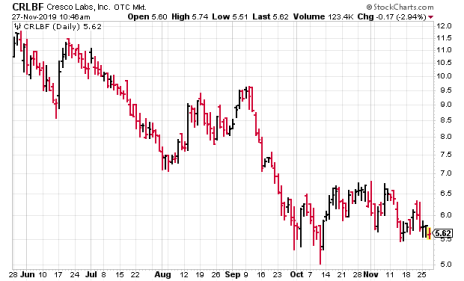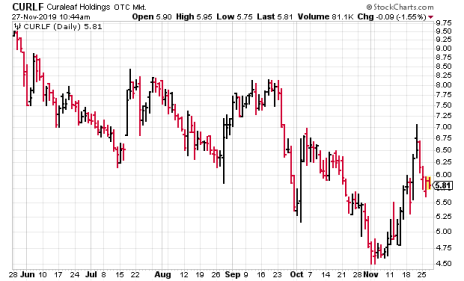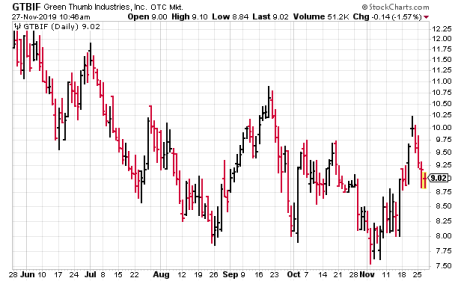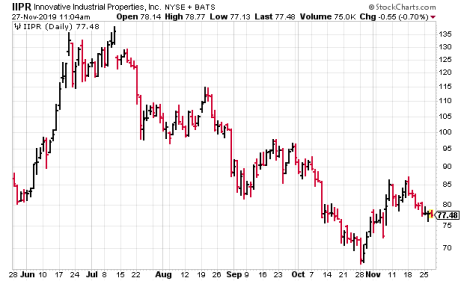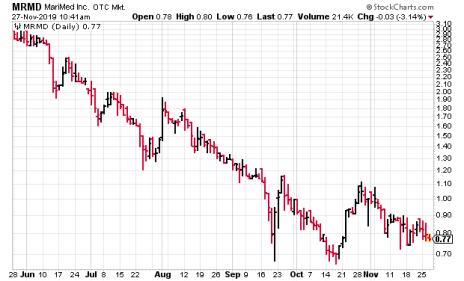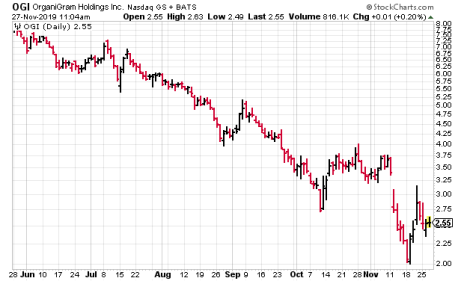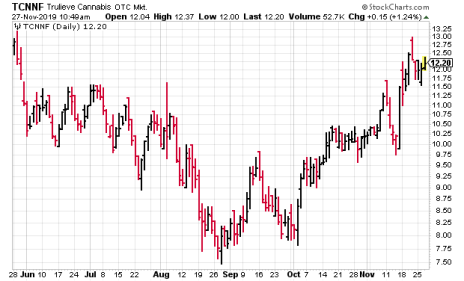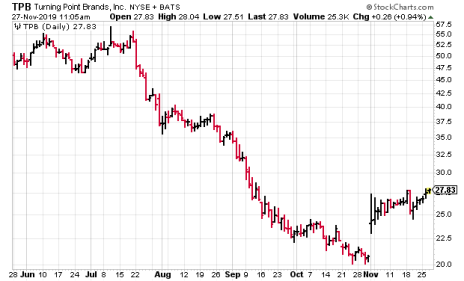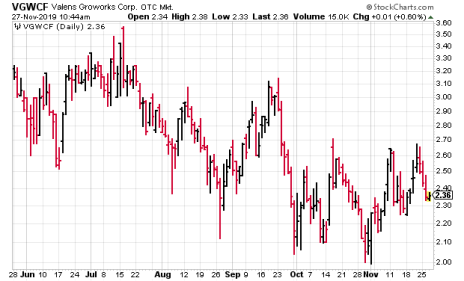The cannabis sector remains in a correction, with Canadian stocks in particular still struggling—even as Cannabis 2.0 promises new retail opportunities. But the fundamentals of the industry remain bright, and investors are now beginning to discriminate between the winners and the losers—with the best stocks showing substantial increases in buying volume recently.
The portfolio remains more than a third in cash, waiting for the sector’s main trend to turn up, and there are just two small adjustments today. The portfolio will sell half its position in Cresco Labs (CRLBF) and double its position in Innovative Industrial Properties (IIPR).
Full details in the issue.
Cabot Marijuana Investor 1119
The Smart Money is Moving In
It’s common knowledge among experienced investors that the price of a company’s stock, at any one time, is imperfectly related to the company’s actual value.
Other factors that affect the price include estimates of the company’s future revenues, earnings and profit margins; projections for the industry; the trend of other stocks in the sector; the trend of the broad stock market; the state of the general economy; and that most mysterious force, investor sentiment.
For cannabis stocks in the U.S., additionally, there’s one more factor. That’s the legality involved in investing in companies trafficking in what is still legally classified a Schedule 1 drug. Most individual investors aren’t dissuaded by this; they figure if their broker will sell the stock to them, it must be okay.
But most institutions are more cautious—and the result is that institutional support of cannabis stocks is far weaker in the U.S. than in Canada. In fact, of the five U.S. multi-state operators currently in our portfolio, the average stock is held by only 10 funds, whereas of the five Canadian licensed producers in our portfolio, the average stock is held by 235 funds. That’s a big difference!
Admittedly, heavy support by institutions did not stem the flood of selling that took Canadian cannabis stocks down 70% from their March highs. Institutions actually increased their holdings as the stocks got cheaper over the six-month period, but the selling of individuals was just too powerful—and that’s because overall, the industry’s stocks remain in the hands of individuals (perhaps 90% now) while only 10% is held by institutions.
But in recent weeks, as quarterly reports have shed some light on which companies are succeeding and which are struggling, I’ve seen clear signs of institutional buying, as trading volume has surged in many of our stocks. Conclusion: The smart money is moving in.
News
Last week I mentioned the Marijuana Opportunity Reinvestment and Expungement Act (MORE Act), which was approved by the House Judiciary Committee and next goes to the full House, where it will likely pass. But then, of course, the Senate is likely to reject it.
This week the FDA issued warning letters to 15 companies for illegally selling products containing CBD in ways that violate the Federal Food, Drug, and Cosmetic Act and added that it cannot conclude that CBD is generally recognized as safe (GRAS) for use in human or animal food.
Specifically, the agency said, “As we work quickly to further clarify our regulatory approach for products containing cannabis and cannabis-derived compounds like CBD, we’ll continue to monitor the marketplace and take action as needed against companies that violate the law in ways that raise a variety of public health concerns. In line with our mission to protect the public, foster innovation, and promote consumer confidence, this overarching approach regarding CBD is the same as the FDA would take for any other substance that we regulate. We remain concerned that some people wrongly think that the myriad of CBD products on the market, many of which are illegal, have been evaluated by the FDA and determined to be safe, or that trying CBD ‘can’t hurt.’
Aside from one prescription drug approved to treat two pediatric epilepsy disorders, these products have not been approved by the FDA and we want to be clear that a number of questions remain regarding CBD’s safety – including reports of products containing contaminants, such as pesticides and heavy metals – and there are real risks that need to be considered. We recognize the significant public interest in CBD and we must work together with stakeholders and industry to fill in the knowledge gaps about the science, safety and quality of many of these products.” Cannabis stocks dipped moderately on the news, extending the downswing that began last Thursday, but I can’t help mentioning that I perceive a major difference in the way the agency is treating CBD vs. the way it treated opioids, which were approved in part because of heavy lobbying by big pharmaceutical firms.
Meanwhile Mexico, which has lost significant black market marijuana business since growing in so many U.S. states has become legal, came very close to legalizing the drug for adult use this month, but a new timeline may push legalization out to April. Changes to the law include limits on foreign ownership (aimed obviously at the very companies whose stocks we own), and limits on both vertical integration and license resale.
In California, taxes on marijuana will be raised January 1, enriching the state’s coffers but increasing the price gap between marijuana in the legal market and marijuana in the still-healthy black market.
And in Canada, mid-December will usher in Cannabis 2.0, when edibles and vapes and beverages with cannabis become legal across the country. I’m very much looking forward to that, but hopes across the board appear low, given the slow pace of Canadian store openings in the first year.
Marijuana Index
It’s been a long seven months down for the index, but from today’s perspective, the bottom came on November 18—particularly because there was some big-volume buying immediately after. From here to year-end, we may see tax-selling forces countered by bargain-hunting forces, but as the New Year approaches, I expect the bargain hunters to take control.
Strategy
My goal, as ever, is to get you invested in the stocks of the companies that will be the leaders of this industry five and ten years from now, as it grows into a $50 billion industry in the U.S. and Canada. I’m currently tracking 148 public companies in the sector, the majority of which trade under a dollar a share and are just too risky to even discuss. But in sticking with the biggest companies and the stocks that are beginning to establish new uptrends, I’m confident that we’ll be able to ride the next uptrend as it develops. For now, the portfolio remains more than a third in cash.
What to Do Now
With most of the bad news (earnings reports) out of the way, your best guide to the future leaders of the sector is the action of the individual stocks—and the most important sign of leadership is a pattern of higher highs and higher lows. Today, the best charts belong to Trulieve (TCNNF), Turning Point Brands (TPB) and Innovative Industrial Properties (IIPR). If you’re buying, try to buy on dips. If you have any big losers (for me the limit is 30%), sell them. Today the portfolio will sell half its position in Cresco Labs (CRLBF) and double its position in Innovative Industrial Properties (IIPR).
CURRENT RECOMMENDATIONS
Aphria (APHA)
Aphria bottomed early last week and then rallied with the sector—and some of those days had big volume, too—but we can’t say the trend is up yet. Aphria remains the largest holding in the portfolio, mainly because it’s the biggest seller in Canada and its stock looks like a decent value relative to its peers. HOLD.
Aurora (ACB)
Aurora is the most heavily traded Canadian cannabis stock as well as the one that’s owned by the most institutions (362), and while that certainly didn’t keep the stock afloat during the big decline, it does explain the big buying volume the stock enjoyed last week. Sadly, the stock has given much of that pop back since. The portfolio holds a minimal position and I’d like to add more once the trend turns up. Fundamentally, the business is growing; Aurora is opening a flagship store in Edmonton at North America’s largest mall. HOLD.
Canopy Growth (CGC)
CGC is the most high-profile Canadian cannabis company, and its stock too rallied on big volume last week—and the good news is that the gains have held! But the stock remains expensive relative to its peers, so I won’t buy until I see some strength. The portfolio holds a minimal position. HOLD.
Cresco Labs (CRLBF)
Turning to the U.S., Chicago-based Cresco Labs is the fourth-largest multi-state operator (MSO) in the U.S., and destined to get even larger once its acquisition of Origin House, which is big in California, is complete. And the stock looks good compared to those Canadians, building a bottom at 5.5 over the past two months. However, the company, like many in the industry, is now working to husband its cash. It recently announced $38 million in non-dilutive funding and then terminated its expected acquisition of VidaCann, which would have cost $120 million. Third quarter results should be released any day now, and I’m feeling overweighted given the risk, so the portfolio will now sell half its position. SELL HALF.
Cronos Group (CRON)
Cronos is the smallest of the Canadian producers in the portfolio, plus, it’s the most expensive of its peers on a price-to-sales basis. But it’s traded in line with its peers in recent weeks, so can be expected to rally when they do. The portfolio remains underweight. HOLD.
Curaleaf Holdings (CURLF)
After Curaleaf released a great third quarter report late last Tuesday, featuring industry-leading revenues of $129 million, CRLBF surged from 5.5 to 7 in just two days on big volume, but now it’s drifted back down. Still, it remains far above its low of 4.5, so the odds are good that the stock is preparing for a renewed uptrend. The portfolio currently holds a heavy position in the stock, in part because the valuation looks good relative to its peers. HOLD.
Green Thumb Industries (GTBIF)
This Chicago-based MSO’s stock looks even better than CURLF because it’s been basing since late August and its 50-day moving average is closer to turning up. Last week’s great quarterly report sparked some high-volume buying that sent the stock briefly above 10 (an important yardstick for this sector), and the stock has retreated normally since. If you don’t own it, try to buy on a normal pullback. BUY.
Innovative Industrial Properties (IIPR)
IIPR has been a great component of the portfolio, partly because it performed so well (until July) and partly because it’s provided great diversification away from growers. The company currently owns 42 properties located in Arizona, California, Colorado, Florida, Illinois, Maryland, Massachusetts, Michigan, Minnesota, New York, Nevada, Ohio and Pennsylvania, totaling approximately 2.9 million rentable square feet—all of which it leases to cannabis companies. IIP’s average current yield on invested capital is approximately 13.6% for these 42 properties, and shareholders’ yield on the stock is currently 4.0%—which is not a number to be sneezed at in the current environment. The stock surged nicely when quarterly results were released three weeks ago and it’s pulled back normally since. The portfolio has taken profits in the stock four times this year, and it is now quite underweight, and this looks like a time to step back in. I’ll double the position. BUY.
MariMed (MRMD)
Massachusetts-based MariMed is the lowest-priced stock in the portfolio and it’s also our biggest loss today, but if we can hang onto it, I think it will do well in 2020, given that it’s an undiscovered bargain. On the other hand, many institutions can’t be bothered to look at stocks in this price range, so progress is more dependent on individual investors. HOLD.
MediPharm Labs (MEDIF)
This firm is the first fully licensed extraction-only cannabis company in Canada, focused on providing value in the middle of the chain while competing with neither growers nor retailers. The stock had been building a base at 3 after a disappointing third quarter report, but this week it fell through that support level and now it’s headed for its old low of 2.5. If it gets there, our loss will approach 30% (our limit), but until then I think it’s worth waiting, particularly with the prospect that Cannabis 2.0 will stimulate more interest in extracting companies. HOLD.
Organigram (OGI)
Canadian producer OrganiGram released its official fiscal fourth quarter results Monday, but the market didn’t react much, mainly because the company had “pre-warned” two weeks previously. Revenues were $19.2 million, up 503% from the year before (but down from the immediately preceding quarter) and there was a net loss of $0.07 per share compared to net income of $0.12 the year before. The problem, stemming from the slow rollout of legal stores in Canada, was “largely due to non-cash fair value changes to biological assets and inventories.” Going forward, the company expects that Quebec will have more than double its retail presence by March 2020, so demand for its output will rise substantially. Additionally, the company will have vaporizer pens, edible products and a powdered drink mixing and packaging line to support the Company’s plan to launch a variety of dried powder formulation beverage products in early calendar 2020. The stock surged with the sector on big volume last week and has given up some of the gain since. HOLD.
Trulieve (TCNNF)
Trulieve has by far the strongest stock in the entire cannabis universe, up eight weeks in a row—and with good reason. The company is the leading seller of medical marijuana in Florida and I expect it to eventually take the lead when adult-use marijuana becomes legal in Florida. And the company is moving into other states as well, including California, Massachusetts and Connecticut. Third quarter results, released Monday of last week, were terrific, and the stock is up 20% since then. Additionally, the stock’s 50-day moving average is trending clearly up and its 200-day moving average is on the verge of joining it. If you haven’t bought yet, you can buy a little here. The portfolio would like to average up, but first I need a little fatter profit. BUY.
Turning Point Brands (TPB)
Turning Point Brands is a well-managed company with a long history of selling other tobacco products, like snuff and chewing tobacco, and it pays a small dividend too, currently 0.7%. But the stock lost 65% of its value from July through October as the vaping scare struck at the company’s hottest growth segment of 2018. However, on November 1 the company released an excellent quarterly report (which included great strides selling CBD) and since then the stock has come back to life; its 50-day moving average is now trending up! The portfolio doubled its position last week and now the stock is at its highest level since September. BUY.
Watch List
Planet 13 Holdings (PLNHF)
Based in Las Vegas, Planet 13 operates the world’s largest cannabis store, which includes a coffee shop, bistro/pizzeria and entertainment complex. The store, supplied by the company’s growing operations in Nevada, now serves more than 3,000 visitors per day but is capable of serving 50,000, and the company has plans for more stores under both the Planet 13 and Medizin names. Third quarter results, released after the market close Monday, saw revenues of $16.7 million, up 241% from the year-before quarter, and a loss of a penny per share, just as in both the immediately preceding quarter and the year-before quarter. The stock bottomed at 1.3 a month ago, and rallied to 1.8, but sold off yesterday after the report. If it can stop here, and then next break out above 1.8, we might have a new uptrend on our hands.
Valens Groworks (VGWCF)
Valens GroWorks is the largest cannabis extraction company in Canada, and the first to be ISO 17025 accredited. Its extraction technologies include sub/supercritical CO2, ethanol, hydrocarbon, solventless and terpenes, and now the company is developing centrifugal separation technology. Its customers include Canopy Growth, Tilray, HEXO, Organigram and The Green Organic Dutchman and it’s producing white label products for Shoppers Drug Mart, the big Canadian pharmacy chain. Going forward, management believes that oil-based products will dominate the cannabis market, and the distillate that it produces is the basis of all oil-based products. Third quarter results saw revenues of $16.5 million, up 87.1% from the second quarter and 641% over the previous year’s quarter. Adjusted EBITDA was $9.8 million, and earnings were $0.05 per share, up from a loss of $0.10 per share in the immediately preceding quarter. Some of that profit was the result of a one-time contract, but analysts are looking for earnings of $0.03 this year and then $0.25 in 2020. The stock bottomed at 2.0 a month ago and has seen some good buying volume since then, but needs to break out above 2.7 before we can say there’s an uptrend.
The next Cabot Marijuana Investor issue will be published on December 26, 2019.
Cabot Wealth Network
Publishing independent investment advice since 1970.
CEO & Chief Investment Strategist: Timothy Lutts
President & Publisher: Ed Coburn
176 North Street, PO Box 2049, Salem, MA 01970 USA
800-326-8826 | support@cabotwealth.com | CabotWealth.com
Copyright © 2019. All rights reserved. Copying or electronic transmission of this information is a violation of copyright law. For the protection of our subscribers, copyright violations will result in immediate termination of all subscriptions without refund. No Conflicts: Cabot Wealth Network exists to serve you, our readers. We derive 100% of our revenue, or close to it, from selling subscriptions to its publications. Neither Cabot Wealth Network nor our employees are compensated in any way by the companies whose stocks we recommend or providers of associated financial services. Disclaimer: Sources of information are believed to be reliable but they are not guaranteed to be complete or error-free. Recommendations, opinions or suggestions are given with the understanding that subscribers acting on information assume all risks involved. Buy/Sell Recommendations: All recommendations are made in regular issues or email alerts or updates and posted on the private subscriber web page. Performance: The performance of this portfolio is determined using the midpoint of the high and low on the day following the recommendation. Cabot’s policy is to sell any stock that shows a loss of 20% in a bull market or 15% in a bear market from the original purchase price, calculated using the current closing price. Subscribers should apply loss limits based on their own personal purchase prices.

